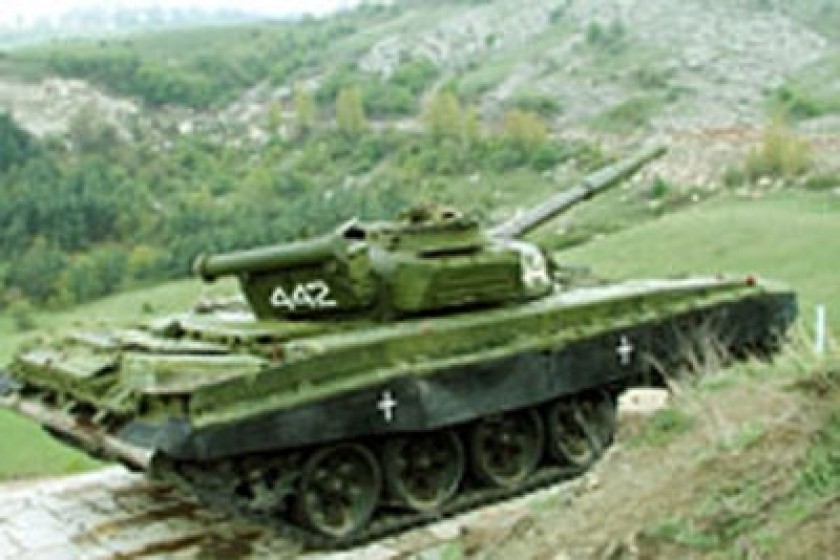
Conversations About War and Peace
"Though it stretched From Sea to Sea in the Past, Armenia Has Withered to a Handful of Land. We Have to Preserve This Land."
"Have you seen how cattle is driven? That how our people were driven - children, old people, mothers - I saw them leave the villages of Martakert in grief and pass by. For me, this was the hardest, the most tragic day of the war. During this war I lost my brother, my nephews, and my brother-in-arms, Samvel Safaryan, a national hero. I mourned the loss of all our boys as I would mourn for my children. But the capture of Shahumyan and Martakert were the hardest for me. Serge Sargsyan sent me to the northern regions of Karabakh to at least provide artillery for the people to be evacuated safely, for their exodus. Teachers, fellow villagers, my relatives, passed by me weeping."
These are words of Georgy Gasparyan, or, as he is more commonly known, Grad Zhora. "You want me to name ten heroes. We should name everyone. What about those who were in the rear - women, children, the elderly - aren't they heroes?" asks the retired general, who was in command of the artillery during the Artsakh liberation war and fought at the front from Omar to the Arax. "I think that the Artsakh liberation war is the most successful of the wars in Armenian history. Armenia stretched from sea to sea in the past, but it withered and withered to a handful of land. We have to preserve this land," he says.
Eighty-there-year-old Roza Avanesyan is one of the thousands of Martakert residents who left their homes during the spring and summer months of 1992. Perhaps, she too passed by Grad Zhora. "We only managed to take with us a pillow and a quilt to wrap the baby in. I left behind my two-story house and my pregnant cows. I tremble all over, I can't talk about it. We started out on the journey pushing and shoving, screaming and crying." This is how Roza Avanesyan from the village of Maragha in Martakert, whose family settled in Lachin, describes the exodus of Armenians.
Vazgen Manukyan saw these scenes too. "After I left the post of prime minister and before my appointment as defense minister I went to Martakert with a small military unit. Martakert had already been captured by Azerbaijanis. On the way, I saw what my grandfather had told me, what I had read in books - the routes of mass exodus. Our people escaped through forests, I saw sheets hanging from trees, children's toys, the smell of unburied bodies."
Eighty-three-year-old Ashkhen Safaryan left behind in Getashen seven decades of her life, a newly built house, and her orchard. She says if she has a chance she'll go home this summer for a visit; she misses her home badly. "On May 6, 1991 Azerbaijanis entered the village and drove the people of Getashen out. Now Azerbaijanis live in my two-story house. I left everything behind; I barely managed to take a bag with me. This summer I want to go home. What can the Turks do to me?" she asks.
The Artsakh war turned more than one million Armenians and Azerbaijanis into refugees and internally displaced persons. More than 400,000 Armenians from Nagorno Karabakh and Azerbaijan and more than 750,000 Azerbaijanis from Armenia, Nagorno Karabakh, and the seven Azerbaijani regions controlled by Karabakh forces left or were driven out of their homes. A whole generation of the two peoples has grown up in the Azerbaijani refugee camps and in various Armenian hostels, hoping to return home one day. Some of them still keep their house keys.
Filmmaker Tigran Khzmalian was a correspondent for the Vesti news program on Russian TV's Second Channel in Karabakh. He believes that in Artsakh, the war was imposed on the Armenian people. "These guys fought knowing that 200 meters behind them was the village where their children, wives and mothers lived. On the opposite side, Azerbaijanis from Baku, Kirovabad and elsewhere came who wanted other people's houses. It was mainly guys from Karabakh villages who fought, backed by those who came from Yerevan, Gyumri, and other places. The fact that the Karabakh villagers were not alone and that even one person from Yerevan had left his family, children, work, or studies and had come to their village to eat their bread, to live with them and die with them meant everything to them." This is how he explains the Armenian victory in the war.
"After the war I made my first feature film. It's called Black and White . The film was awarded the Grand Prix in Turkey and in Russia. It wasn't about the Karabakh war; it was about war in general, about World War II. But of course, my main experience was the Karabakh war. It is a film about a mountainous village where only women are left and only one man has returned from the war. There were two colors left in Artsakh during the war, not black and white but black and khaki. All the men wore khaki - camouflage, and the women wore more and more black as time went by. The spread of the color black was the greatest pressure, the biggest impression left by the Artsakh war," the filmmaker says.
 Videos
Videos Photos
Photos
Write a comment